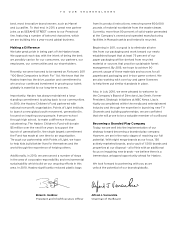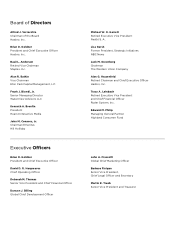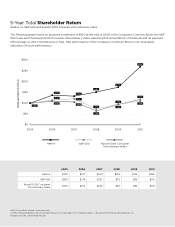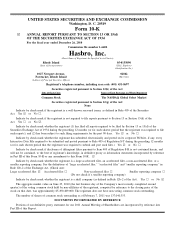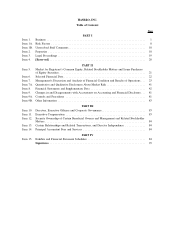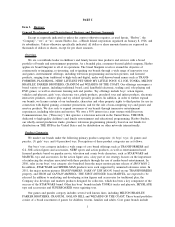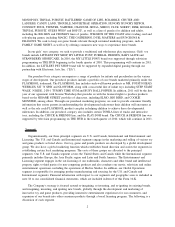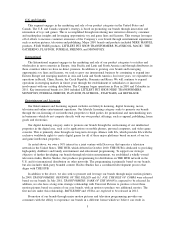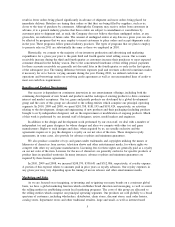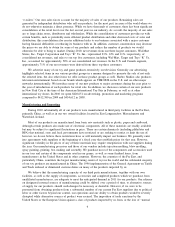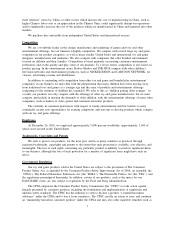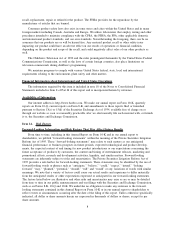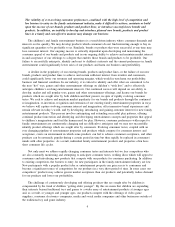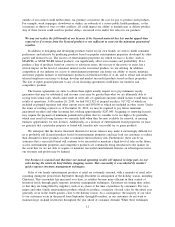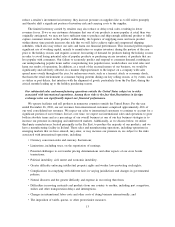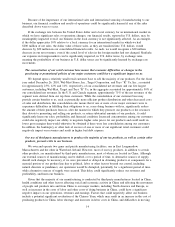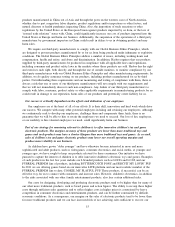Hasbro 2010 Annual Report Download - page 15
Download and view the complete annual report
Please find page 15 of the 2010 Hasbro annual report below. You can navigate through the pages in the report by either clicking on the pages listed below, or by using the keyword search tool below to find specific information within the annual report.
result in fewer orders being placed significantly in advance of shipment and more orders being placed for
immediate delivery. Retailers are timing their orders so that they are being filled by suppliers, such as us,
closer to the time of purchase by consumers. Although the Company may receive orders from customers in
advance, it is a general industry practice that these orders are subject to amendment or cancellation by
customers prior to shipment and, as such, the Company does not believe that these unshipped orders, at any
given date, are indicative of future sales. The amount of unshipped orders at any date in a given year can also
be affected by programs that we may employ to incent customers to place orders and accept shipments early
in the year. These programs follow general industry practices. The types of programs that we plan to employ
to promote sales in 2011 are substantially the same as those we employed in 2010.
Historically, we commit to the majority of our inventory production and advertising and marketing
expenditures for a given year prior to the peak third and fourth quarter retail selling season. Our accounts
receivable increase during the third and fourth quarter as customers increase their purchases to meet expected
consumer demand in the holiday season. Due to the concentrated timeframe of this selling period, payments
for these accounts receivable are generally not due until later in the fourth quarter or early in the first quarter
of the subsequent year. The timing difference between expenses paid and revenues collected sometimes makes
it necessary for us to borrow varying amounts during the year. During 2010, we utilized cash from our
operations and borrowings under our revolving credit agreement as well as our uncommitted lines of credit to
meet our cash flow requirements.
Royalties and Product Development
Our success is dependent on continuous innovation in our entertainment offerings, including both the
continuing development of new brands and products and the redesign of existing products to drive consumer
interest and market acceptance. Our toy, game and puzzle products are developed by a global development
group and the costs of this group are allocated to the selling entities which comprise our principal operating
segments. In 2010, 2009 and 2008, we spent $201,358, $181,195 and $191,424, respectively, on activities
relating to the development, design and engineering of new products and their packaging (including products
brought to us by independent designers) and on the improvement or modification of ongoing products. Much
of this work is performed by our internal staff of designers, artists, model makers and engineers.
In addition to the design and development work performed by our own staff, we deal with a number of
independent toy and game designers for whose designs and ideas we compete with other toy and game
manufacturers. Rights to such designs and ideas, when acquired by us, are usually exclusive and the
agreements require us to pay the designer a royalty on our net sales of the item. These designer royalty
agreements, in some cases, also provide for advance royalties and minimum guarantees.
We also produce a number of toys and games under trademarks and copyrights utilizing the names or
likenesses of characters from movies, television shows and other entertainment media, for whose rights we
compete with other toy and game manufacturers. Licensing fees for these rights are generally paid as a royalty
on our net sales of the item. Licenses for the use of characters are generally exclusive for specific products or
product lines in specified territories. In many instances, advance royalties and minimum guarantees are
required by these license agreements.
In 2010, 2009 and 2008, we incurred $248,570, $330,651 and $312,986, respectively, of royalty expense.
A portion of this expense relates to amounts paid in prior years as royalty advances. Our royalty expenses in
any given year may vary depending upon the timing of movie releases and other entertainment media.
Marketing and Sales
As we are focused on re-imagining, re-inventing and re-igniting our many brands on a consistent global
basis, we have a global marketing function which establishes brand direction and messaging, as well as assists
the selling entities in establishing certain local marketing programs. The costs of this group are allocated to
the selling entities which comprise our principal operating segments. Our products are sold globally to a broad
spectrum of customers, including wholesalers, distributors, chain stores, discount stores, mail order houses,
catalog stores, department stores and other traditional retailers, large and small, as well as internet-based
5



